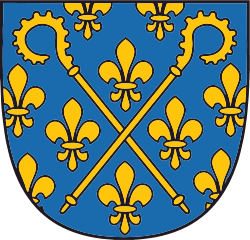Holy Trinity Abbey, Lough Key
| Mainistir na Tríonóide | |||||||||
|
Arms of the Order of Canons Regular of Prémontré | |||||||||
 Location within Ireland | |||||||||
| Monastery information | |||||||||
|---|---|---|---|---|---|---|---|---|---|
| Other names | Lough Key Abbey | ||||||||
| Order | Order of Canons Regular of Prémontré (Premonstratensians) | ||||||||
| Established | 1215 | ||||||||
| Disestablished | 1608 | ||||||||
| Mother house | Prémontré Abbey, Picardy | ||||||||
| Diocese | Elphin | ||||||||
| People | |||||||||
| Founder(s) | Clarus Mag Máilin | ||||||||
| Architecture | |||||||||
| Status | inactive | ||||||||
| Heritage designation |
| ||||||||
| Style | Norman | ||||||||
| Site | |||||||||
| Location | Trinity Island, Lough Key, County Roscommon | ||||||||
| Coordinates | 53°59′21″N 8°15′17″W / 53.989217°N 8.254697°W | ||||||||
| Public access | yes | ||||||||
Holy Trinity Abbey is a former medieval Premonstratensian priory and National Monument located in Lough Key, Ireland.[1][2]
Location
Holy Trinity Abbey is located on Trinity Island, an island of 0.9 ha (2.2 ac) in the southern part of Lough Key, facing Rockingham House.[3]
History
A monastic site existed on the island from the 7th century AD, and a gable and church doorway of the 9th century survive. Holy Trinity Priory was founded in 1215 by Clarus Mag Máilin, archdeacon of Elphin, the island being gifted by Cathal O'Reilly, king of East Bréifne. Some monks came here from Boyle Abbey in 1228.[4] It was raised to abbey status c. 1235. The standard claustral plan was envisaged but only the east range was actually built.[5]
It acquired a daughter house on Lough Oughter, County Cavan in 1237.
The religious and lay brothers were buried within the abbey and in two cemeteries on the island. In 1436 the anchoress Gormflaith died here.[6] Excavation suggests that the building to the north of the church was rebuilt after burning down in the 15th century, and this is confirmed by an annal entry in 1466 which blamed a fire on "the negligence of a woman."[7] The Annals of Loch Cé, covering events between 1014 and 1590, were written here.
Holy Trinity Abbey was held in commendam by Ruaidri mac Diarmata (Rory MacDermot, King of Moylurg) from 1548 and granted to a Robert Harrison in 1594. Sir Conyers Clifford was buried there in 1599. The last monks left in 1608 when King James I confiscated the monastery.
One tomb on the island is of Úna Bhán MacDermot ("Fair Úna"). She was daughter of Brian Óg MacDermot (king of Moylurg 1603–36) who refused to let her to marry Tomás Láidir Costello ("Strong Thomas"), the son of one of his enemies. She died of a broken heart, and Tomás is said to have swam across to weep at her grave. Later he died too, and was buried next to Úna.[8][9][10]
A 1991 excavation found silver coins of Henry VIII and Elizabeth I, bronze ferrule, iron knife and nails, pottery and rotary quern fragments.[11]
Buildings
The Abbey was constructed from the local rocks: pale grey sandstone and limestone.[12]
The church contained sedilia and chapter room.
References
- ↑ https://openlibrary.org/books/OL22636278M/Archaeological_excavations_at_Holy_Trinity_Abbey_Lough_Key_Co._Roscommon
- ↑ Clyne, Miriam (1 January 2005). "Archaeological Excavations at Holy Trinity Abbey Lough Key, Co. Roscommon". Proceedings of the Royal Irish Academy. Section C: Archaeology, Celtic Studies, History, Linguistics, Literature. 105C (2): 23–98. JSTOR 25506230.
- ↑ "Stock Images, Medical Scientific & Historical Photos - DIOMEDIA".
- ↑ "Lough Key Forest Park".
- ↑ "Medieval Lough Cé: History, Archaeology and Landscape". Four Courts Press. 1 January 2010 – via Google Books.
- ↑ McAvoy, Liz Herbert (7 October 2016). "Anchoritic Traditions of Medieval Europe". Boydell & Brewer Ltd – via Google Books.
- ↑ "Lough Key Abbey (Walsh)".
- ↑ aiveencooper (28 March 2013). "Lough Key Forest Park".
- ↑ Clyne, Miriam (1 January 2005). "Archaeological Excavations at Holy Trinity Abbey, Lough Key, Co. Roscommon". 105C (-1). doi:10.3318/PRIC.2005.105.1.23.
- ↑ "Roscommon Genealogy IGP".
- ↑ "1171 « Excavations".
- ↑ "Trinity Island Lodge - About the Island".
